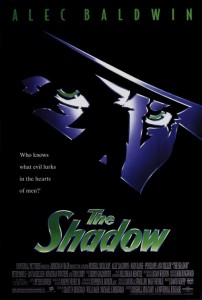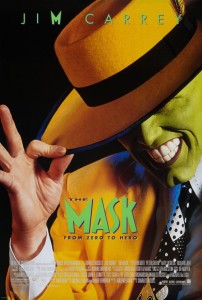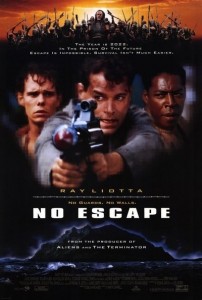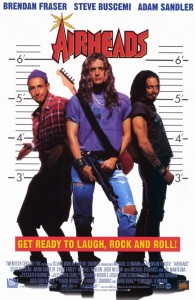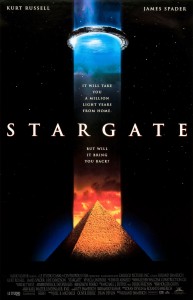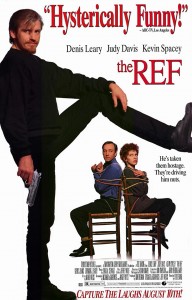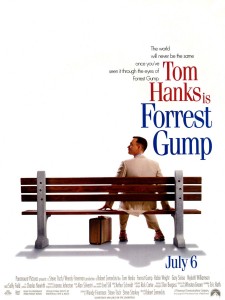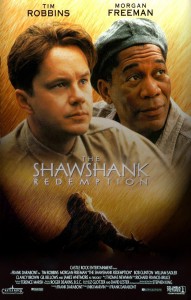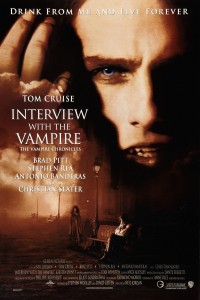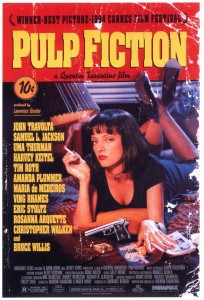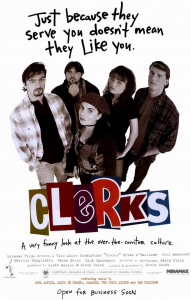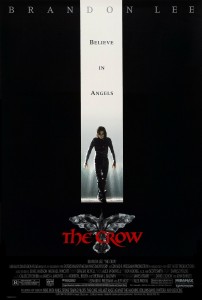1994: The Dream of the Nineties In Film

So, Where Was I In 1994?
This was a year where I started to come together as a human being. I’d been in my high school music program for two years. Along with my visual arts training, this was where I’d finally started to feel like I had a place of refuge. I’d risen to a section leader in the marching band, was swapping in and out of first chair positions between me and a friend of mine who, no shit, was named Tom Jones. This marked a two year period where sometimes, just sometimes, high school could be fun. The bullies got a new target somewhere (I didn’t care where), I wasn’t an underclassman any longer, and I felt strangely in control of where things were headed for once.
This was also the year where the movie theaters couldn’t keep me out. I turned seventeen this year – old enough to show an ID to someone in the ticket booth and validate my presence there. This didn’t mean my folks were always pleased with my viewing habits. It was a push to get in to see Pulp Fiction that year (a film my mother would later see in her sixties and love).
While the internet had been something I’d used for a while, this was the year it really started to gel for me personally. We were still on dial up, using the much maligned AOL service. Squelches and beeps were a part of every day life, as was the vocal shouting of “MOM! I’M ONLINE! DON’T PICK UP THE PHONE!”
The world continued to move along. NAFTA got barreled through congress and was signed by Slick Willie. Congress flipped to Republican control, which set the stage for an impending impeachment. The PowerPC was released by Apple, and the blurring of platforms started a short time later as the internet brought rival operating systems a bit closer together in terms of compatibility. Rodney King got a shit ton of money in reparations for the violation of his civil rights, further blackening the eye of the LAPD’s public image. To add to the mix of crazy in Los Angeles, Nicole Brown Simpson and Ron Goldman are found dead at Brown’s home, resulting in the ‘Trial of the Century.’ The nation plastered itself to the television as Brown’s and Goldman’s suspected killer – football hero, OJ Simpson – took off in a low speed chase with one of his former teammates, Al Cowling.
As always the films of the year continued to mold and shape me. This was a great year for film. This year still informs a lot of my writing and creative sensibilities. Some excellent storytelling came to me, and no doubt 1994’s films will continue to shape me in years to come as my fiction continues to grow.
The Schlock
The Shadow
When I Saw It: 1994
What It Taught Me: Pulp Tropes, A Furthered Love For Art Deco
Rating: ★★★
My music courses were not limited to school hours – practices were both before and after the standard six-and-a-half hour school day. Dad would drive me to practices while we listened to audio dramas. One of the dramas was, of course, The Shadow. Sometimes the titular character was voiced by Orson Welles, other times by William Johnstone and Bret Morrison. This time, we’d get to hear Alec Baldwin perform not just the voice, but the man’s visage – provided alter ego Lamont Cranston would let us see him. I remember being really worked up to see this film.
The movie was okay. It lacked the punch of the other year’s films, mostly because of it’s moderately campy leanings. They overdid it a little, particularly with Tim Curry who plays a patsy for the main villain. It’s hard to overuse Tim Curry – but he put in a little too much extra it might have been better to tuck it back.
What remains with me from the film though was the presentation of Manhattan in the forties. Much like with The Rocketeer (1991), there was a heavy deco leaning to the set that lingers with me, informing me (for better or worse) of the motifs of the times. It also gave me more lead in the pencil for describing and setting the stage for that particular era. It also helped to cement a lot of the tropes and plots of that time: two fisted goons working under shady manipulators versus the one man with special abilities that can stop them.
The Mask
When I Saw It: 1994
What It Taught Me: 2D to 3D Effect Transition, A Little Carrey Goes Too Far
Rating: ★★★
I am not particularly a Carrey fan (we’ll get into this a bit more in 1994’s Cutting Room Floor). His signature ability in the 1990’s was to be completely and totally off-the-wall. I’m not certain how he got more energy than Robin Williams had (though one might suspect illicit substances which were also Williams’s forte), but he put it to good use in the Mask.
I liked the concept of this piece, though I’m told it did veer from the canon according to fans of the original Dark Horse Comic from the 80’s and 90’s. It’s the story of an everyman guy, Stanley Ipkiss (played by Jim Carrey), who finds a mask that basically turns him into a nigh-invulnerable, green-skinned trickster so long as he wears it. The Mask comes with some unfortunate complications though, and soon Stanley can’t really keep up with all of the things the Mask gets up to when it’s in control – and it manages to get Stanley into binds ever more frequently the longer he wears it. When Tina Carlyle (Cameron Diaz’s first appearance), hits up Stanley’s bank to open an account. She’s really there get info on banks to rob for the mob. Stanley falls in love with her, and soon The Maskis all over her, and the mob doesn’t like this one bit. Slapstick violence and Jim Carrey being Jim Carrey ensue.
This wasn’t a particularly great film, though for its time its effects were remarkable. Additionally, it was the goal of the team to bring the manic energy of not only Carrey, but the well-respected and talented animator, Tex Avery. Tex is regarded as one of my gods in my pantheon of art, so it was no big surprise that I liked at least that part. They more or less got it down in these clips.
Somewhere In the Middle
No Escape
When I Saw It: Circa 1996
What It Taught Me: Complex Dystopia, Better Than Lord of the Flies
Rating: ★★★★
I’ll admit that my recollections of this film are somewhat hazy, but I remember really liking it. As far as I am concerned, the plot is easily explained thus: Escape From New York (1984) on an island. Ray Liotta is Snake Plisken, but there’s no President to be rescued. Liotta just wants off the island to clear his name and expose the corruption that landed him on a remote prison island in the pacific.
I mean, really, framing any movie as ‘Escape From New York, But…’ will pretty much get me to watch it (Escape From New York has been a favorite since I watched it in 1993). I love movies like that portray fantastical societies bred by human nature left to its own devices in strange places. I shouldn’t like movies like this based on my reception of Lord of the Flies (see my Disastrous freshman year in an earlier post). All William Golding really needed to say was ‘the fat kid with glasses dies first when society’s rules go away.’ I knew that because I was a fat kid with glasses. Social dynamics weren’t lost on me. But, what Escape From New York and No Escape had was the set dressing and cool toys on occasion. That and a bad ass guy at the center who had the right antihero tropes.
I really want to revisit this now to see if it still holds up well. It had a pretty good cast with Liotta at the center, and a good array of B-listers surrounding him: Lance Henriksen, Ernie Hudson, and Kevin Dillon.
Airheads
When I Saw It: 1994
What It Taught Me: Soundtrack Love
Rating: ★★★★
So, you have a floundering band that can’t seem to get a break. No one is listening because you’re not on the radio. All doors are shut. How do you open one?
Take a radio station hostage.
Of course the guns are fake – these guys don’t have the stomach for real violence. They figure they’ll use plastic (but real looking) uzi-styled water guns, a little bravado, and get the station playing their new single. What could go wrong?
This is a pretty stupid plan so things go wrong almost immediately. From there on it’s a heartwarming tale of rock and roll revolution, the magic of music, and obligatory Stockholm Syndrome.
What I remember though were two things: Harold Ramis’s appearance, and the Soundtrack. In particular the song ‘I’ll Talk My Way Out of It‘ by Stuttering John. Yes, that Stuttering John. Yes, you may question my good taste.
Additionally, this was around the time that the three lead rockers were all getting big. I knew Adam Sandler from Saturday Night Live and his comedy CD ‘They’re All Gonna Laugh At You’, Steve Buscemi was becoming a favorite after seeing Reservoir Dogs (1992), and Brendan Fraser had a string of successes. All three were on their way to big things during this movie’s filming and release.
Stargate
When I Saw It: 1994
What It Taught Me: Diaspora
Rating: ★★★★
A fringe Egyptian Linguist (James Spader) is brought into a top secret project initiated by the Unites States Government by an aging scientist who believes his work will unlock a great mystery. He accepts and finds himself under the command of a high ranking military man with a haunted past (Kurt Russel). Russel’s project is related to an ancient artifact found in Egypt and taken by the US military. They have no idea what it does, but they have a couple ideas. Once Spader joins the team, they realize the artifact is a portal – but to where they have no idea. So, they get volunteers led by Spader and Russel to go through the portal and into a world that seems very much like Egypt. The locals at the other end of the portal are shockingly human, they have their own language derived from Egyptian… and they are brutally oppressed by alien masters who appear to have been the architects of the entire ancient Egyptian societal structure. The aliens were, in fact, their gods. Spader and Russel then go on to liberate the oppressed world and to presumably exploit the hell out of the gate system they’ve discovered after the credits roll (the film even got a set of spin off shows on The SciFi Channel).
The idea of extraterrestrial human societies as the norm appealed to me. That humans were not unique to earth or might even be the ‘typical’ species found in space due to a forgotten diasporas in the ancient past really took seed and sprouted story ideas for years to come. The film’s visual effects also served as reference for me years later in college – a lot of FX heavy films did, though this one sticks out due to the rippling water effect of the gate.
The Ref
When I Saw It: 1994
What It Taught Me: Stretching the Concept of a Christmas Movie, Escalation
Rating: ★★★★
Denis Leary hit me like a lightning bolt with his comedy disc ‘No Cure For Cancer’ in 1993. It got listened to a lot, so when he had top billing in this dysfunctional family comedy, I leaped.
Leary plays a career thief. He decides to pull a job on a millionaire’s house on Christmas Eve. He’s caught up by a trap in the house that identifies him. This sends him on the lam, looking for a place to go to ground and wait out the dragnet. To accomplish this he kidnaps a couple (Kevin Spacey and Judy Davis) who have been at each other’s throats for years. He coerces them into keeping him hidden under the threat of violence against their juvenile delinquent son. This gets Leary embedded in Spacey and Davis’s own family problems when he realizes the best story he can use as a cover for the arrival of their relatives is to pretend that he’s their marriage counselor. When the extended family arrives, things get much, much worse for everyone and things escalate to a spectacular breaking point.
This is not only a great comedy, but it’s a movie I watch around Christmas every year, along with Die Hard and Gremlins. Much to my mother’s disappointment.
Personal Blockbusters
Forrest Gump
When I Saw It: 1994
What It Taught Me: A Deeper Sense of a World Before Me, What Special Effects Could Really Do
Rating: ★★★★
This was easily the hit of the year for most audiences (though not my personal favorite if the title banner of the article didn’t give it away). Tom Hanks really showed his chops with this one, and sent his career down a notably different path from most of his past performances.
Hanks portrays Forrest Gump, a good natured man of lower-than-average intelligence. He has a storied and exceptional life despite his many challenges. He starts from humble origins, the illegitimate son of a hard-working mother who does anything she can to raise him right. The story goes from his early years, through adolescence, through his time in the military and Vietnam, and then an improbable celebrity that comes after. Throughout the film, he traverses several high mark moments of history that have been emblazoned into the Baby Boomer experience. It’s an amazing work that encompasses so many themes and emotions that it’s difficult to catalog all of them. It really did deserve its critical acclaim.
One of the (many) things that it won awards for though was its special effects. Up to this point, effects from the computers of hard-working FX staff was on the purely fantastical. We’d seen Jurassic Park, which gave us some of the most realistic looking dinosaurs that have ever been set to film. Space battles were looking cooler. Lava was flowing without causing a hazard to people on sets. No one had yet though to start using computer generated effects to replace what might feel like mundane practical shots. Things like say… a wandering feather. This film showed that you could do the impossible, and make it look practical. The feather wasn’t the only thing though. The film manages to place Hanks in existing and modified footage with known celebrities and politicians; to set an olympic class ping pong game up without having to do take after endless take to get it right; and to get the weather to cooperate on command. It really opened up the boundaries of what was possible.
Additionally, it started to put a lot of what I’d only read about in my history classes into context. I knew that there was a world before I came into it, but no one had really sat me down to show how it affected everyone else – or at least no one had for many of the film’s moments (I actually had wonderful US and World History teachers in my public school, plus my Dad to fill in some blanks). This opened up my understanding on things like the Vietnam War, the Civil Rights Era, and the Fifties and Sixties in general.
The Shawshank Redemption
When I Saw It: 2017
What It Taught Me: Layers On Layers
Rating: ★★★★★
You read that right – I just watched this movie this year. It’s hard for me to believe I never saw it sooner. Truth be told, I’d seen the back third of the film many times. The movie airs on cable on the regular. It’s one of those movies I have a theory about: you can watch twenty-four hours of television a day and have it all be either The Shawshank Redemption or Law and Order just by flipping through multiple channels. There’s no period of time when those titles are not playing. They’re that popular.
Having had the ending blown for me, I just never really got around to the beginning, which is a shame because the movie is that fucking good. My girlfriend and I sat down to watch it about a month ago after she properly chastised me for not having watched it earlier in life. I am quite pleased with it. The movie deftly performs acts of cinematic magic.
The story opens with the trial of Andy Dufresne (Tim Robbins) who very well may have killed his wife. He is sentenced to life imprisonment in Shawshank Prison where he has a great struggle adapting to life inside of the prison walls. He does however make friends, notably another lifer named Red (Morgan Freeman), and begins to ease into the life of a convict as much as one can. He suffers a great many indignities. He is beaten and raped; brutalized in mind, body, and spirit. He is often at odds with both his jailers and his fellow inmates. He not only perseveres – he retains his humanity while working toward his elaborate liberation.
The drama is amazing – but I expect that from most Morgan Freeman films. What really got me with this was the depth of the plots. Most good films have subplots – stories that weave in and around the main one. Usually there’s one or two. This one has many. They’re layered in so that the subplots seem to have subplots. It adds to the length of the movie, but in such a gripping way that you won’t mind sitting through 142 minutes of film. Time just melts away. You simply take in all of the layers as easily as breathing. It just takes your breath away.
Interview With the Vampire
When I Saw It: 2017
What It Taught Me: How To Build a Relatable Monster
Rating: ★★★★★
When I look back at it, this was what started the trend of vampires starting in my youth until my second bout of college. We’ve had zombies in the mind for the last eight years (barring a sudden outbreak of vampirism in the form of Twilight (2008) but we can expect vampires to come back due to a weird kind of political phenomenon. Let’s hope they can get more Anne Rice and less sparkling.
The film opens with a man who has nothing left to live for. Louis (Brad Pitt) has lost both wife and child to a tragic pregnancy. Lost and without purpose, he puts himself in harm’s way, begging for something to put him out of his misery. The vampire Lestat (Tom Cruise) takes this as an open invitation and preys on him, eventually taking him on as his child of darkness, transforming Louis into a vampire. This begins the extended life of Louis the vampire. The two quickly find themselves at odds: Louis will not kill with the glee of his father of darkness, but must lest he waste away and molder in some forgotten crypt.
The film essentially is about Louis coming to terms with his nature, learning to walk the fine balance between man and beast. He suffers great trials of emotional fortitude, navigates moral quandaries, and ultimately suffers terrible consequences for his actions (such as the making of his own child of darkness, an actual child turned vampire named Claudia (Kirsten Dunst). The film is an emotional rollercoaster punctuated with horror and despair. I am a fan of morality pieces and situations where there is no wrong and right. It creates an environment where you’re never really sure what’s going to happen, and this had that effect.
This is also one of the rare cases in which the movie outshone the original book in my opinion. I’ve tried three times to read the book and never finished – yet I’ve seen the film dozens of times.
Pulp Fiction
When I Saw It: 1994
What It Taught Me: Non-Linear Storytelling, Making The Horrific Hilarious
Rating: ★★★★★
It was a fight to see this movie. I mean, I tried like hell to get in. This film was released just a short time before I turned seventeen. The movie’s reputation and outrage of parent groups had ticket sellers checking for IDs. I’d gone to see R-Rated films at the theater before. Even a couple without parents present. But this film. Oh man.
On my fourth try, I finally got the money, the available time, and a license I could slap on the counter that no one would deny. My cousin and I chose one of the oldest, seediest theaters in the area. The last time I’d been there was to see The Jungle Book (1967) when I was a kid. And, oh boy, did we not see anything family friendly when that curtain opened.
This movie was transformative in terms of not just content, but also in terms of storytelling. It covers a couple of different stories: one about two robbers deciding to rob a diner on impulse; another about a pair of hitmen trying to get a suitcase back to their boss; another about a boxer who refuses to through a fight for a crime boss; and another about a crime boss’s goon who’s given the task of taking his lady out on the town so she doesn’t get bored. Each is broken up into its own vignette, and each story ties into each other story in ways either trivial or of great consequence. They’re not told in any order either. In fact, they’re totally shuffled. It’s the kind of film where the end is the beginning is the end. Everyone has read the story where you start in media res and you jump between now and then. But this took that idea to a higher plane of existence. It was masterfully done. Tarantino outdid himself with this film, and it’s the one that made me follow his career for good or ill over the next decade.
It also transformed careers. John Travolta had been in a slump, as had Bruce Willis, but this film got them rising from the ashes anew. Samuel L. Jackson had been working steadily, but this was the film that I feel opened bigger doors for him. Uma Thurman definitely took off, and Tim Roth graduated from quirky roles in unexpected gems to helming films as a lead role. You also got Eric Stolze as a scummy LA drug dealer, Christopher Walken as a family friend I think no one would want, and then you got Ving Rhames, who definitely took off after this film cemented itself into cinema history.
The thing that stuck with me most though was the Car Scene. I’m pretty sure you know what I’m talking about, but I’ll spell it out for you. After Travolta and Jackson finish up a job in which they should have died in a hail of unexpected gunfire, they are taking a man to their boss in the car. Jackson claims epiphany, that god had directly intervened on their behalf, resulting in Jackson’s belief that this is his last day working for crime boss Marcellus Wallace. Travolta isn’t having it and an argument starts. Eventually, Travolta, looking for support for his side of the debate, turns to their passenger in the backseat, gestures his gun at him to emphasize his point… and the pistol goes off accidentally, resulting in a spectacular spray of gore and blood as the passenger’s head disintegrates.
That’s a pretty shocking thing to have happen. It’s the kind of thing that if it happened in front of you in real life, you’d be absolutely horrified. There’d be years of therapy. Lots of neuroses. Total breakdown.
I could not stop laughing.
Neither could the rest of the people in the theater. But, me especially. I was laughing four minutes later, out of breath. People were staring at me. They must have thought I was a psychopath (I wondered this too driving home from the film).
There was just something about it. The suddenness and the fact that after it happens, Travolta and Jackson just continue to bicker with almost no pause. And while they are both upset, they never stop to deal with the morality of killing a dude by accident. Travolta doesn’t hardly even raise his voice. To him it’s like discussing the price of weed. They just argue about how they’re going to finish the job and what to do about having a car filled with blood and brains in the freeway. It was such a shock, followed by an incredibly inappropriate response that the absurdity of it lit up every humor circuit in my head.
I guess that makes me a pretty bad person.
Clerks
When I Saw It: 1994
What It Taught Me: Irreverence, Timing, An Appreciation of Black-and-White Medium In a World of Color
Rating: ★★★★★
I’ve noted before that my parents were extremely restrictive on what I could watch. They might lose in the battle of films on the big screen, but they could police what came into the house. They weren’t always consistent though, and they couldn’t watch me all the time. Public school teachers pretty much work all day, so sometimes I could sneak in a little something.
I missed Clerks in its entirety for it’s film run. This was no big surprise – it was an indie film from Miramax that didn’t get a huge run. I finally saw it on video later in the year when a student of my dad’s brought it over during our weekly comic book run.
Denis Leary had paved the way for comedy that would get me in trouble for listening to it at anything louder than a whisper’s volume, but it still didn’t quite prep me for Clerks level of brutal honesty and total vulgarity. This punched up my obscenity meter by leaps and bounds. Considering I grew up in a school district where the word ‘fuck’ almost could replace birdsong, this was no mean feat. I could swear like a sailor before I was nine and this opened up whole new vistas of foul mouthedness and wholly inappropriate behaviors.
Along with that, it also gave me another great foundation on how to execute timing. Timing is everything, but especially so with comedy. Smith has a great sense for it, and would go on to use it to great effect in further endeavors in the Askewniverse such as Mallrats (1995) and Dogma (1999). It’s timing is almost Sorkin-esque, but with a little more room to breathe.
The thing that really gets me though was that this film was so low-budget that it had to be filmed in black-and-white. I kind of held black-and-white television and film in low regard back in 1994. Mostly, it was because I was stupid – I had this idiotic belief as a kid that newer is always better. Kevin Smith wasn’t from the fifties or sixties, and there was no excuse for outdated film options when you could get ‘better.’ This was a film which set me on a path of being older and wiser.
I don’t think Clerks would have been as powerful if it had been shot in color. As someone who’s had the experience of working in a crap retail job, it kind of robs the color out of your life. Sure, it’s there, but you’re not feeling it. The only thing you feel is the click of the keys at the register, the crying of someone’s baby, throwing a chronic masturbator out of the store, or the complaining of someone who feels ill used (rightly or not) by capitalism. It takes the film’s nature and starkly puts it in front of you. It’s not the only film to have made this deliberate choice in a world of color (The Mist, which showed in color ultimately, had a special cut of the intended black-and-white version in the BluRay edition), but it’s one of the better ones.
The Crow
When I Saw It: 1994
What It Taught Me: Everything
Rating: ★★★★★
If you ask me what my favorite book is, I’ll tell you Neuromancer without thinking. If you read that book and then read any of my science fiction stories for just a couple of minutes, it’s likely you’ll see how deeply the book informs who I am as a person and an author.
I mention that book not out of an inherent plot connection, but because The Crow is my cinematic counterpart to Neuromancer. When I write horror in an urban hellhole, you might catch Eric Draven wandering in the alleys, watching.
The Crow is about Eric Draven (Brandon Lee): a man returned to life after he and his fiancee are murdered on Devil’s Night by a gang of arsonists and killers. He finds that he has not only cheated death, but that he is granted powers from a great crow that seems to accompany him everywhere he goes. He seems to be invulnerable to any kind of physical punishment. He has the ability to get psychic impressions from the past by holding objects or touching people. He is stronger and faster, and has a newfound capacity for great violence. He can see through the eyes of the crow. He can vanish without trace. But, lastly, he possesses an eerie knack of being in the right place at the right time to set things as right as they can be set.
He instinctively knows that he will never be able to bring his love back to life – but he can make sure that the men who killed his bride-to-be will never kill again. He will make sure that every last one of them get exactly what they have coming to them.
With his supernatural talents, he goes on to avenge the deaths of his fiancee and himself, cutting a murderous swath through a city infested with darkness and depravity. One by one, he takes on his killers, leaving a trail of fire, blood, and crow symbology in his wake.
This movie drips with all of the dark horror conventions I like to work with in my fiction: The merciless world that often seems to actively work against you – not in some abstract way, but rather a city that attacks you like it’s personal; despair in alleys; dark recesses of urban blight that are best avoided; crews of criminals in an organized nightmare court who will do anything, knowing no restraint; supernatural forces that move within light and shadow; uncaring parents and drug abuse; ubiquitous and callous violence; all-encompassing vengeance; doing the right thing the most wrong ways; moral ambivalence; hope, false or otherwise.
This is fear country. This is the ultimate in revenge.
It’s also visual poetry. The stage is set, and the actors going through it make it sing. The fights are well choreographed (it helps that Eric Draven is played by Brandon Lee, Bruce Lee’s son). The lighting is just so. Fire and darkness mix to create long shadows and a gothic feel. The performances are solid. It feels real despite the supernatural elements. I have watched it over and over again. There’s not a shot shown, not a line of dialog, not an action cue that I do not know like the back of my hand. This is my toolkit, by bible for portraying darkness – and also redemption.
Because, amongst the other things the film embodies, The Crow is also a romance. Draven doesn’t kill out of some kind of personal vengeance. He does this for Shelley. For his lost love. He has returned, but she has not. What he does, he does for her. All of it. Be it guarding over their local street kid, Sarah; be it connecting with Officer Albrecht (Ernie Hudson) to thank him for staying with Shelley in her final hours; be it taking out not just their killers but the man who stood behind them and ordered it- it is all for Shelley Webster. Once the job is done, he fades with her into the afterlife, her personal angel of vengeance come home for his reward.
It chills me to think about it. It thrills me to write something as in vein. It has been an inspiration, and is easily at the top of all of my film loves.
